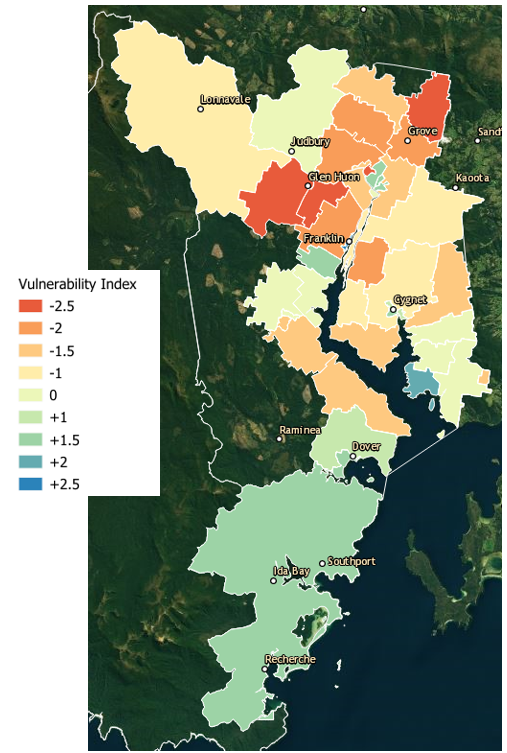Climate change risk is defined as the interaction of hazards (i.e. climate-related variations, events, and trends that may cause damage and harm), exposures (i.e. the nature and degree to which a domain is exposed to variations and stress from climate hazards), vulnerabilities (i.e. the degree to which a domain is susceptible to, or unable to cope with, adverse effects of climate hazards), and responses (i.e. negative side effects of management implementation, inability to achieve objectives, and existing actions). Risks can be felt across natural, social, built, and economic domains, requiring a comprehensive adaptation approach that is often beyond the scope of Council responsibility.
In the Huon Valley, climate change will exacerbate extreme weather events, intensify changes in ecosystems, and worsen lives and livelihoods for humans, including health, economics, agriculture, and community wellbeing. Additionally, climate hazards are increasingly compounding and cascading, leading to unpredictable scenarios and increased risk.
The main climate risks for the Huon Valley, as identified through external climate modelling and internal Council surveying include:
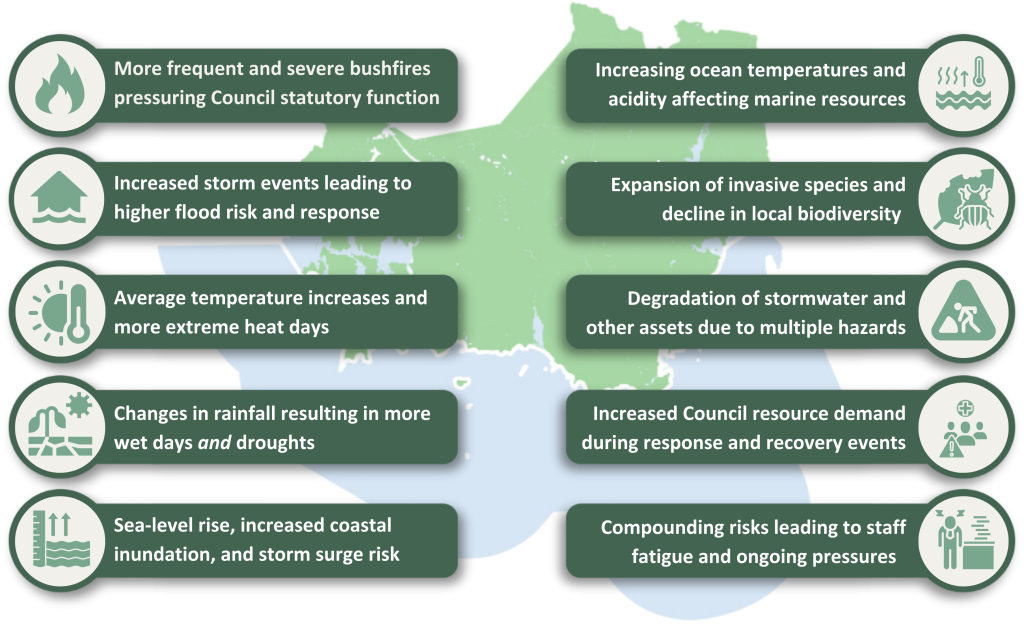
What are climate change risks?
Climate change risk is defined by the interplay between the likelihood and impact of climate-related hazards, the vulnerability of communities and ecosystems, the degree of exposure to these hazards, and the effectiveness of responses to mitigate or adapt to these risks.

Hazard refers to potential events or physical conditions that can cause harm or damage, ranging from acute events like storms and bushfires to chronic changes such as drought and sea-level rise.
Vulnerability is the susceptibility of a system to the impacts of hazards and encompasses physical, social, economic, and environmental factors, along with adaptive capacities.
Exposure is the presence of people, livelihoods, environmental services, and resources in places that could be adversely affected by hazards, and considers both direct impacts and indirect effects, such as displacement or economic loss.
Responses are actions taken before, during, or after a hazard event to manage its impact, which includes institutional, community-based, or individual. Responses can significantly influence the outcome of climate risk positively or negatively, shaping the potential for recovery, adaptation, and resilience.
Huon Valley’s Climate Hazards
Incremental Climate Trends
Observed shifts in our climate system reflect long-term changes in temperatures, precipitation patterns, sea levels, and extreme weather events. These trends, while global in scope, manifest distinctly in local environments. They are part of a broader pattern of climate change driven by global warming and are evidenced by increasing temperatures, altering rainfall regimes, and rising sea levels worldwide. Grounded in both local observations and broader global contexts, the Huon Valley is experiencing and is likely to experience:
- Increasing Temperatures: The Huon Valley has a temperate maritime climate. Long-term average temperatures have risen since the 1950s at a rate of up to 0.1°C per decade. The increasing temperatures are marked by rising annual averages and more frequent hot days, diverging from historical norms established over the past century. This warming trend exacerbates heat-related health risks, stresses on water resources, and alterations in agricultural cycles.
- Changes to Rainfall Patterns: The average annual rainfall across the municipality is currently around 1790mm. There has been a decline in average annual rainfall since the ‘baseline period’ (1961-1990). These significant changes in rainfall indicate shifts towards more intense rain events interspersed with prolonged dry periods. This departure from historic rainfall norms affects the availability and predictability of water resources, which are crucial for agriculture, natural ecosystems, and urban water management.
- Sea-Level Rise and Storm Surge: The Huon Valley faces escalating risks from sea-level rise and storm surges. Historically stable sea levels are rising, leading to more frequent and severe coastal inundation, erosion, and damage to coastal infrastructure. Storm surges, intensified by higher sea levels, compound these impacts, threatening properties, livelihoods, and ecosystems along the coastline.
- Influence of Climate Drivers: Tasmania’s southern region, including Huon Valley, is significantly influenced by large-scale climate drivers. For example, the extended dry spell of 1995-2009 coincided with an ‘El Nino’ pattern; the dry spell of 2018-20 coincided with an Indian Ocean Dipole event; and extended wetter spells, such as between 2020-2022, often coincide with the dominance of a ‘La Nina’ climate driver. These patterns have historically contributed to extended periods of both dry and wet conditions. Climate change is expected to intensify the effects of these climate drivers, leading to more severe and potentially damaging flood and storm events.
Other risks Huon Valley is experiencing include more frequent and intense heatwaves due to extreme temperature variations, stressing public health systems with increased heat-related illnesses, elevating energy demand for cooling, and threatening biodiversity. Concurrently, alterations in evaporation rates are reducing soil moisture levels, impacting water supply reliability, and challenging traditional agricultural practices with irregular watering needs for crops.
Extreme Weather Events
The acute manifestations of climate change occur through unusual, severe, or unseasonal weather conditions, including bushfires, heatwaves, heavy rainfall, droughts, and storms. The science linking climate change to the frequency and intensity of these events is well-established, as a warming planet alters weather patterns and atmospheric conditions. Understanding and preparing for extreme weather events is crucial for Council, as they represent immediate and visible impacts on communities, infrastructure, and natural systems. Based on past experiences and future predictions, the Huon Valley can expect an increase in severity and frequency of:
- Bushfires: In the Huon Valley, bushfire risk continues to increase due to rising temperatures and changes in rainfall patterns. This elevates the likelihood of more frequent and intense bushfires, impacting air quality, property, and ecosystems. Council faces challenges in enhancing fire management strategies, improving emergency response capabilities, and building community resilience against this escalating threat.
- Riverine Floods and Storms: Driven by changes in rainfall patterns and the intensity of storm events, the Huon Valley is witnessing an increased risk of riverine floods and storms, with a notable shift from historical patterns towards more intense and frequent events. This trend contributes significantly to flooding risks, challenging existing infrastructure and emergency management practices.
- Droughts: Drought conditions in the Huon Valley are becoming more severe and prolonged, diverging significantly from historic precipitation patterns. This increasing aridity contributes to water scarcity, affecting agriculture, ecosystems, and urban water supply.
- Extreme Heat Days: The increase in extreme heat days, as compared to previous temperature norms, contributes to more significant health risks, especially for vulnerable populations, increased energy demand for cooling, and stress on local ecosystems.
Other extreme weather events likely to impact the Huon Valley include heavy rain and gale-force winds that can lead to road obstructions from fallen trees and flash flooding. Heatwave conditions exacerbate bushfire risks and contribute to smoke pollution, affecting air quality and health. Furthermore, a combination of low pressure, high tide, and sometimes high river levels could lead to unprecedented coastal inundation. These compounding events strain Council’s economic and human resources, challenging their capacity to manage and respond effectively to these increasingly frequent and severe weather phenomena.
Ecosystem and Habitat
Climate change is causing intricate transformations within natural environments. These include coastal erosion, ocean warming, the spread of invasive species, and the decline of native flora and fauna. The underlying science links these shifts directly to climate change, emphasising the complex and often indirect pathways through which ecosystems are affected. Unlike the more immediate impacts of extreme weather events, ecosystem changes are gradual, pervasive, and challenging to reverse. This complexity makes adaptation and response strategies critical yet more difficult to design and implement, requiring a deep understanding of ecological dynamics and long-term environmental trends. Ecosystem transformations that will impact on the Huon Valley include:
- Coastal Erosion and Sediment Transport: Intensified by sea-level rise and more frequent storm surges, the Huon Valley is increasingly facing coastal erosion and changes in sediment transport. These changes are already reshaping the coastline and threatening coastal infrastructure, cultural sites, and natural habitats.
- Warmer Ocean Waters and Ocean Acidification: The region faces warmer ocean waters and ocean acidification challenges. These conditions, exacerbated by climate change, can disrupt marine ecosystems, affect fish populations, and harm shellfish by altering the chemistry of the water.
- Expansion of Pests and Invasive Species: The Huon Valley is already experiencing an expansion of pests and invasive species, a trend accelerated by climate change. These species adapt more quickly to changing conditions than native species, leading to disrupted ecosystems, impacted agricultural practices, and threatened local biodiversity.
- Loss of Native Species and Habitats: The ongoing loss of native species and habitats will be exacerbated by climate change through shifts in temperature, precipitation, and the spread of invasive species. This trend significantly threatens biodiversity, ecosystem services, and cultural identity.
Additional and compounding risks to ecosystems and habitats include climate-induced changes in fire regimes, which can alter habitat structure and species composition, and sea-level rise affecting freshwater systems through saltwater intrusion. These shifts challenge Council to integrate fire management with conservation efforts and to explore strategies for safeguarding freshwater habitats.
Lives and Livelihoods
Climate-induced changes, such as increased temperatures, altered weather patterns, and extreme weather events, directly affect physical and mental health, influence economic and agricultural sectors, and disproportionately affect vulnerable populations. These risks underscore the importance of the Council’s role in responding to these impacts, despite the broader contributing factors often being beyond local governance control. Impacts on lives and livelihoods in the Huon Valley include:
- Health Risks: The region faces increasing health risks from climate change. For example, a rise in disease prevalence may occur as warmer conditions expand the environments of disease vectors. Poor air quality from bushfires and heatwaves will exacerbate respiratory conditions and cardiovascular diseases. Additionally, climate-related stresses contribute to mental health challenges, including anxiety and depression, as communities face the direct and indirect impacts of climate events.
- Economic Impacts: The Huon Valley is increasingly vulnerable to economic impacts stemming from climate change, with extreme weather events leading to significant disruptions in local economies, including agriculture and tourism. These events can cause productivity loss and infrastructure damage, adversely affecting local businesses and employment. Additionally, the region faces heightened insurance premiums as the frequency and severity of these events increase, placing a financial strain on individuals and the broader community.
- Agricultural Losses: Climate change is altering growing seasons, degrading soil health, and raising food security concerns. These changes, driven by fluctuating temperatures, erratic precipitation, and extreme weather, challenge traditional farming practices, which are crucial for the region’s economy and employment. The unpredictability of growing seasons, alongside diminishing soil fertility due to shifts in climate patterns, demands adaptive agricultural practices and sustainable land management.
- Community Vulnerability: Climate change exacerbates social vulnerabilities, making specific populations more susceptible to its impacts. Increased climate events can lead to the displacement of individuals, putting additional strain on housing and community services. The potential for displacement, coupled with the heightened demand for emergency services and social support systems, challenges Council to enhance resilience and support mechanisms for the community’s most vulnerable members, ensuring equitable access to resources and services before, during, and after climate-induced events.
Compounding, Cascading, and Protracted Hazards
In the context of climate change, compound, cascading, and protracted hazards represent a complex interplay of events that amplify risks and extend the duration of impacts. Compound hazards occur when two or more events strike simultaneously or in close succession, magnifying the damage. Cascading hazards unfold as an initial event sets off a chain of disasters, each triggering the next in a domino effect. Protracted hazards are extended events with lingering effects, challenging immediate recovery and resilience. The Huon Valley anticipates experiencing more compound, cascading, and protracted hazards. To address these challenges, Council must prioritise integrated risk assessments, enhance early warning systems, and develop multi-hazard response plans incorporating community resilience building and infrastructure adaptation to withstand these interconnected hazards. Intersecting hazards include the combined impact of:
- Heavy rain and gale force winds associated with storms, which may cause road cuts due to both fallen trees and flash flooding;
- Heatwave conditions associated with bushfire and smoke pollution;
- A confluence of low pressure, high tide, and in some, cases high river levels, have the potential to result in unprecedented coastal inundation;
- Compounding events that exhaust the economic and human resources of councils to manage and respond;
- Evaporation and longer dry periods coupled with more extreme temperatures increasing the occurrence and intensity of bushfires, with more starts due to lightning strikes;
- Heavier rainfall events than witnessed historically, particularly from east-coast lows, leading to high daily runoff events causing erosion, landslips, or flooding; and
- Inundation in vulnerable coastal areas due to sea level rise leading to the potential for infrastructure damage and erosion, especially when there is a confluence of low pressure, high tide, and localised flooding.
Huon Valley’s Exposures
Exposure of the Huon Valley community to climate change is structured around four interconnected domains—natural, built, social, and economic—each representing a distinct yet interrelated aspect of our environment and society (Figure 9). These domains, informed by insights from Geoscience Australia, community and expert consultation, and guided by the National Climate Resilience and Adaptation Strategy, provide the foundation for assessing how climate change may affect the region.
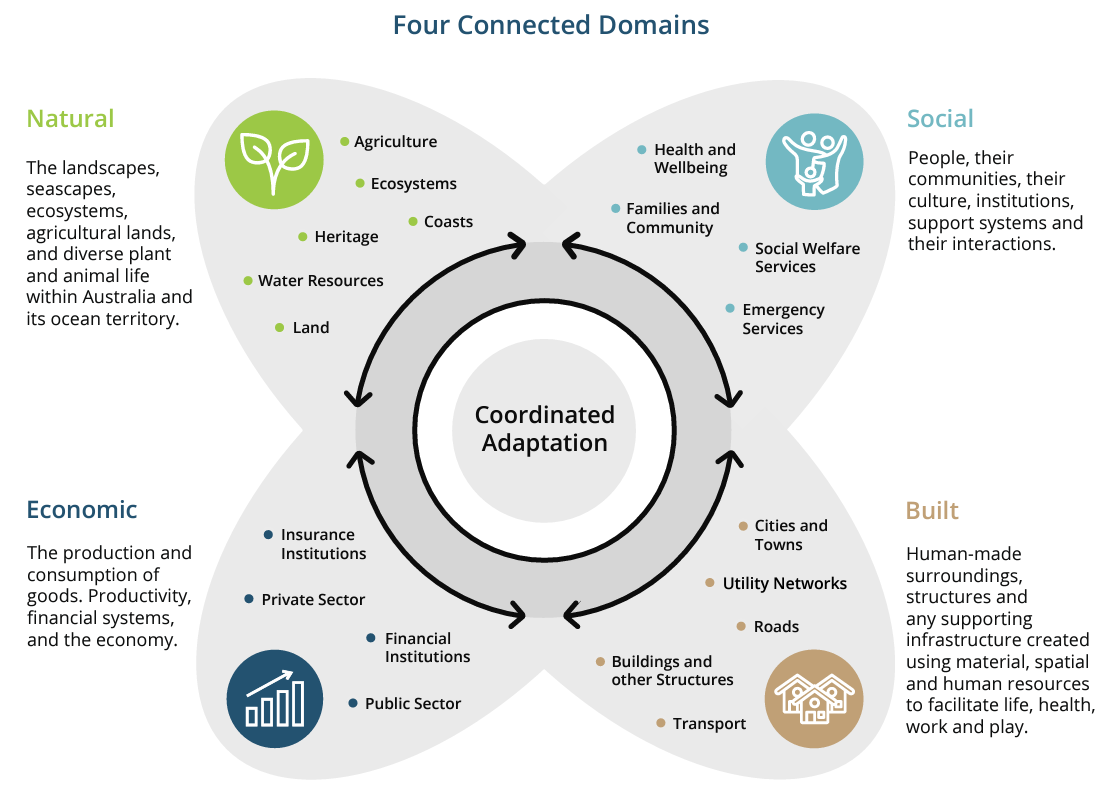
Social Domain Exposure
The Social Domain focuses on people, their communities, cultures, support systems, and institutions. It underscores the importance of social cohesion, public health, education, and emergency services in the face of climate change. Recognizing and addressing the social impacts of climate change, particularly on vulnerable populations, is critical for fostering an adaptive and resilient community. Climate change poses significant risks to the health and wellbeing of Huon Valley residents, particularly through the increased frequency and intensity of heatwaves, which can lead to heat stress, dehydration, and exacerbated chronic health conditions. The Huon Valley’s residents, 38.1% of whom report one or more health conditions – slightly above Tasmania’s average – face added vulnerabilities. Warmer temperatures and altered rainfall patterns further risk increasing vector-borne diseases, compounding public health challenges in adapting to these evolving climate conditions. Enhancing the healthcare infrastructure to cope with the expected increase in climate-related health issues, along with community education and preparedness programs, will be crucial for mitigating these risks.
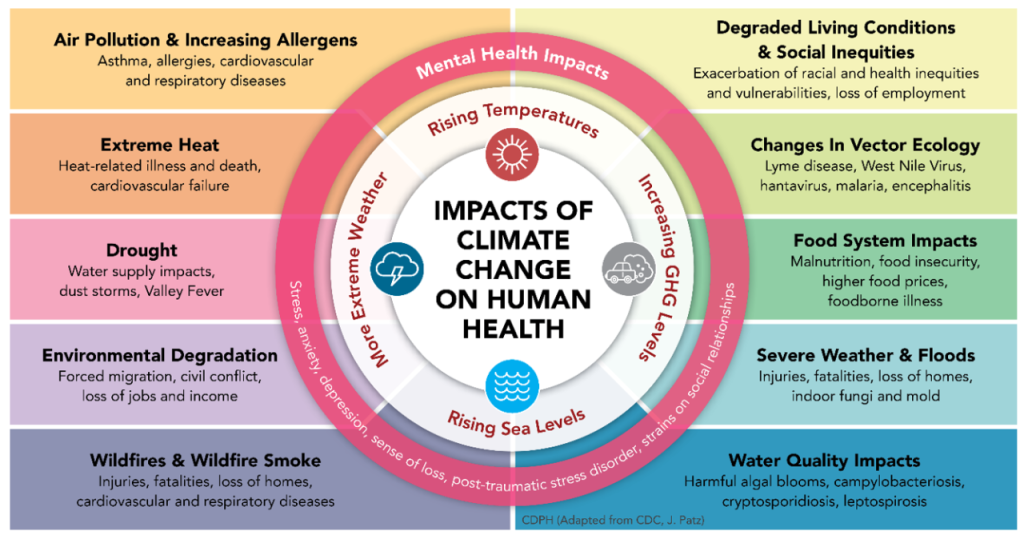
In the Huon Valley, the social fabric of families and the broader community plays a vital role in building resilience against climate change. With 990 couples with young children in 2021, comprising 13.3% of households, the structure of families and their embeddedness in social networks are crucial factors in how climate risks are perceived, managed, and mitigated. Families face direct and indirect exposures to climate change. Extreme weather events pose immediate physical threats to family homes and livelihoods, disrupting daily life and, in severe cases, leading to displacement. Psychological stress and uncertainty associated with these events can strain family dynamics and mental health. Social networks within the Huon Valley are vital in providing support before, during, and after climate-related disasters. These networks, encompassing friends, extended family, community groups, and local organizations, act as critical support systems. However, climate risks can fragment these networks—displacement due to extreme weather can separate families from their support systems, while prolonged droughts or economic downturns from crop failures can lead to community fragmentation as individuals and families relocate in search of better opportunities.
Relatedly, social welfare services are critical in supporting the community, especially the most vulnerable, during times of need. In 2021, 1,209 people (or 6.6% of the population) in the Huon Valley Council municipality reported needing help in their day-to-day lives due to disability, this was a similar percentage to 2016. Climate change exacerbates the pressures on social welfare services through increased demand from those with existing conditions affected by extreme weather, and through direct impacts on service delivery infrastructure. For example, heatwaves can worsen health issues for vulnerable populations, while flooding and bushfires may damage facilities and disrupt service provision. The integration of climate resilience into social welfare planning becomes imperative to ensure these services remain accessible and effective, even as the frequency and intensity of climate-related events increase.
The exposure of emergency services to climate change is twofold: an increased demand for response during and after extreme weather events, and the direct impact on their infrastructure and capacity to provide timely assistance. In the Huon Valley, emergency services are integral to the community’s safety and resilience, especially in the face of increasing climate risks. With four police stations, 12 fire stations, two ambulance stations, and one SES (State Emergency Service) facility, the region is equipped to respond to a variety of emergency situations. However, the escalating severity and frequency of climate-related hazards present significant challenges to these critical services.
Built Exposure
The Built Domain includes infrastructure, buildings, and urban spaces—elements that define where people live, work, and play. Climate change poses risks to the built environment through extreme weather events, sea-level rise, and increasing temperatures. Adapting the built environment involves making it more resilient to these impacts, ensuring safe, liveable, and sustainable spaces for all community members.
In Huon Valley, the built sector—encompassing a range of residential, commercial, industrial, and various community structures (Table 1) with a cumulative reconstruction value greater than $6 billion—faces significant exposure to climate-related hazards. The primary concerns include floods, bushfires, heatwaves, erosion, and sea level rise. Each of these hazards presents distinct risks to the built environment. For instance, bushfires pose a direct threat to residential areas, potentially leading to the loss of homes and infrastructure. Floods and rising sea levels undermine the structural integrity of buildings, disrupt economic activities, and exacerbate the challenges faced by the community.
The immediate impacts of these hazards on the building sector are multifaceted. Floods and bushfires lead to direct damage to properties and assets, necessitating costly repairs or complete reconstruction. For example, 163 buildings (1.8%) are in flood-prone areas, while 7,138 buildings (80.6%) are in fire-prone areas. Heatwaves and erosion contribute to building materials’ degradation, reducing structures’ lifespan, and increasing maintenance costs. Moreover, these physical threats complicate the construction process in vulnerable regions, potentially resulting in stricter building codes and higher compliance costs.
Policy and market shifts aimed at addressing climate change also introduce new exposures for the building sector. As regulations evolve to encourage resilience and sustainability in construction practices, the industry may face increased costs associated with adopting new standards. Furthermore, the insurance market’s response to heightened risk levels could lead to higher premiums or reduced coverage availability, placing additional financial burdens on property owners. These policy and market dynamics not only impact the economic landscape for new constructions but also affect existing buildings that may not meet emerging standards, potentially leading to depreciated values or increased retrofitting costs.
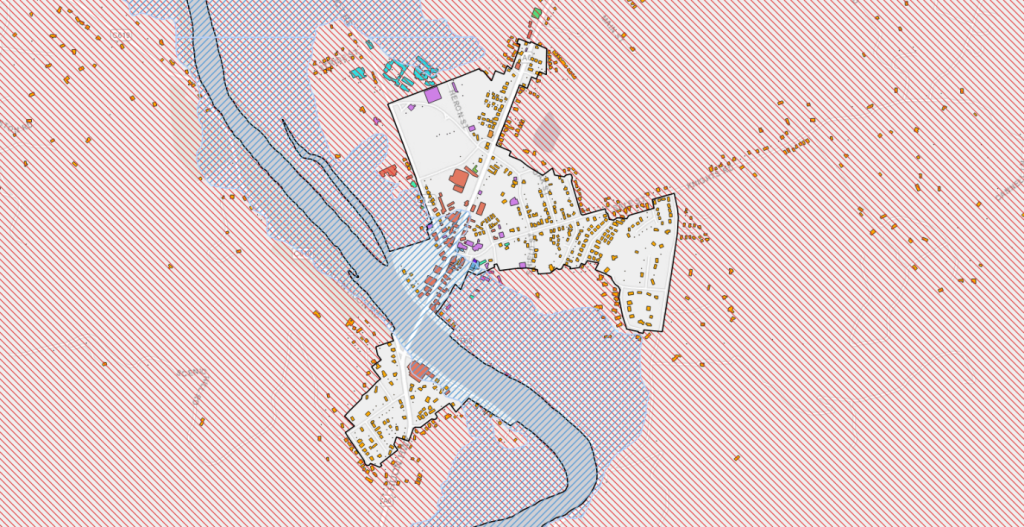
Economic Exposure
The Economic Domain deals with the region’s productivity, industries, and employment. Climate change can affect economic stability and growth by impacting key sectors such as agriculture, tourism, and fisheries. Ensuring our economy can adapt to these changes is essential for maintaining and enhancing the livelihoods and prosperity of the Huon Valley’s residents.
In Huon Valley, the economic sector is inherently sensitive to climate change, notably agriculture, forestry, and fishing, which collectively employ 24% of the Council’s population. These sectors, contributing 25.71% to the southern region’s agricultural value and accounting for 43% of Huon Valley’s economic output in 2021/22, is positioned on the frontline of climate change exposure. The economic ramifications extend beyond primary production, affecting the health care, social assistance, construction, education, training, and retail trade sectors that together form the top five employing industries in the municipality. Specifically, primary producers and the environmental tourism industry in Huon Valley are deeply reliant on a stable climate, as fluctuations can dramatically affect agricultural yields, natural resource availability, and the region’s natural beauty that attracts tourists.
Climate variability, including extreme events such as droughts, floods, and bushfires, poses significant financial stress to agricultural businesses and, by extension, the broader economic landscape of Huon Valley. Research indicates that agricultural profitability is highly dependent on climatic conditions, with the most profitable years featuring high rainfall and favourable commodity prices, while drought years with unfavourable prices are notably less profitable. Drought conditions can lead to a polarised economic outcome among farmers, creating a scenario of ‘winners and losers’ based on the ability to produce under adverse conditions and benefit from drought-induced commodity scarcity.
The complexity of drought impacts on farming is multifaceted, affecting productivity, outputs, input prices, and their interplay. Factors such as labour requirements, fodder transport, machinery efficiency, and changes in irrigation needs contribute to individual farming operations’ economic resilience or vulnerability during drought. Moreover, the economic exposure to drought is not confined to local weather conditions but is influenced by market dynamics, such as increased feed prices driven by drought in other regions affecting even those experiencing average local weather.
The exposure to climate hazards extends to other sectors crucial to Huon Valley’s economy. For instance, environmental tourism, an emerging pillar of local economic development, faces vulnerability to climate-induced natural disasters, which can deter tourist inflow and impact related retail and service industries. Floods and bushfires threaten agricultural and forestry outputs and disrupt the infrastructure critical for local industries and tourism, leading to business interruption and loss of income.
Addressing the economic exposure of Huon Valley to climate change necessitates a comprehensive understanding of the sector-specific and systemic risks posed by climate variability. While droughts present immediate and direct challenges to agricultural productivity and profitability, the broader spectrum of climate hazards—including floods and bushfires—demands an integrated approach to resilience planning. This includes considering the impacts on primary producers and the interconnected effects on the entire local economy, from environmental tourism to the sectors that support the livelihoods of the community.
Natural Exposure
The Natural Domain encompasses landscapes, ecosystems, agricultural lands, and biodiversity. The natural domain is essential for well-being, cultural heritage, and the economy. It faces direct impacts from climate change, such as altered species distributions, increased bushfire risks, and challenges to agricultural productivity. Preserving natural capital and enhancing the resilience of the ecosystems are paramount for adapting to these changes.
Huon Valley’s natural environment, a cornerstone of its identity and economy, is increasingly vulnerable to the impacts of climate change. The region’s coastalscape, including the Huon River, conservation areas, national parks like Hartz Mountains and Southwest National Park, and its coastal regions, not only provide residents with a high quality of life but also attract tourists from around the globe. This relationship between the community and its environment is underscored by the designation of protected areas across the Huon Valley, highlighting the region’s commitment to preserving its natural beauty and biodiversity. This is further demonstrated by the designation of environmental-associated codes in the Interim Planning Scheme.
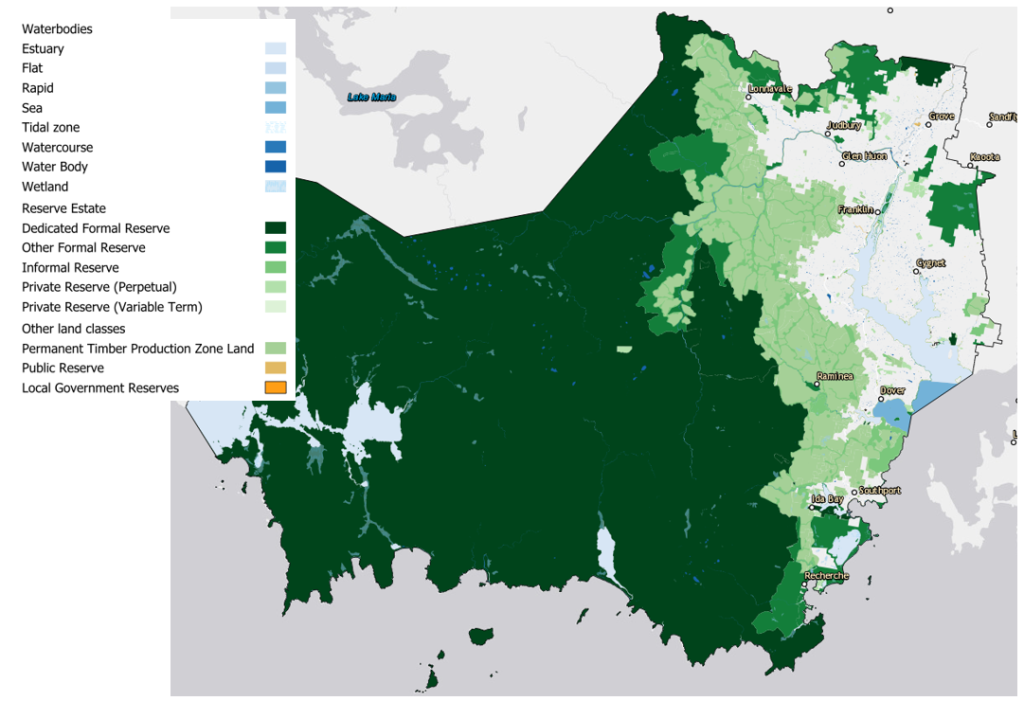
However, natural values of the Huon Valley are under threat from climate change and the associated hazards. Recent severe bushfires, such as those from 2018-19, have already demonstrated the devastating impact on the natural environment, destroying vast areas of national parks, conservation spaces, and affecting the community’s health and well-being with smoke. Likewise, the Huon River’s tendency to overflow, along with coastal vulnerabilities to storm events, highlights the region’s susceptibility to flooding and erosion, threatening both natural and human-made assets.
Moreover, the potential for increased extreme heat events poses risks to the urban and natural landscapes of the Huon Valley, especially areas lacking adequate canopy cover, which can exacerbate local temperatures and impact ecosystems and human health, leading to compounding and cascading hazards across the four connected domains.
Huon Valley’s Vulnerabilities
Community vulnerability refers to the degree to which a community is susceptible to, and unable to cope with, adverse effects of climate change, including climate variability and extremes. Vulnerability is a function of a community’s exposure to hazards, its sensitivity, and its adaptive capacity. Huon Valley’s specific vulnerabilities reflect the region’s demographic, socio-economic, and environmental characteristics.
A notable percentage of the population requires assistance in their daily lives due to disability, underscoring the need for accessible and inclusive adaptation measures. The presence of older residents, single-parent families, and those without access to personal transportation further highlights groups that may have limited capacity to respond to and recover from extreme weather events or longer-term climate shifts. The Socio-Economic Indexes for Areas (SEIFA) data reveals a concentration of disadvantage in the Huon Valley, with a significant number of dwellings falling within the lower deciles of socio-economic status. This economic disadvantage can limit the community’s overall ability to invest in adaptive infrastructure or services and recover from climate-induced damages.
The Social Vulnerability Index, based on recent research, identifies the vulnerability to natural hazards based on a combination of socioeconomic status, demographics and disability, minority and languages, housing characteristics, and built environment. Areas within Huon Valley with higher social vulnerabilities, such as Mountain River, Ranelagh, and Glen Huon, are characterised by factors such as lower income levels, higher dependence on agriculture, and limited access to services, and may thus face greater difficulties in adapting to climate change. Conversely, areas like Huonville and Franklin show lower social vulnerability, suggesting different capacities within the community to manage and adapt to climate risks.
